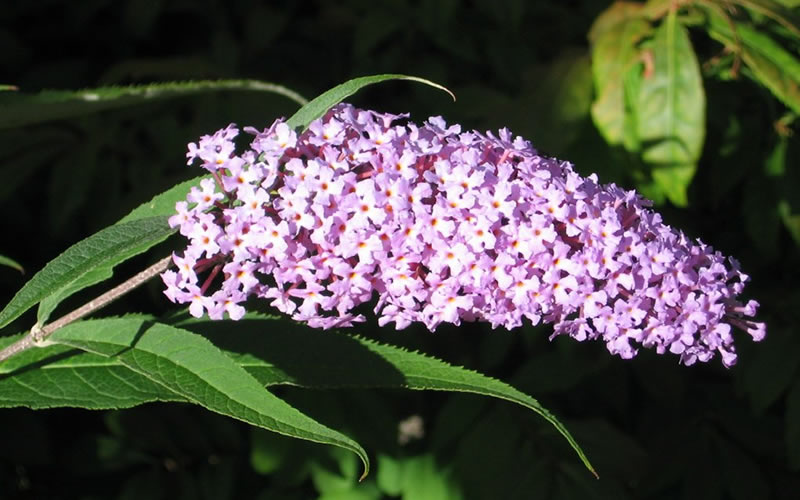The butterfly bush (Buddleja species) is a favorite among gardeners. Its long, fragrant, colorful flower spikes attract legions of hungry butterflies. The plant is easy to grow. In well drained soil, it can withstand a wide range of climates, from very wet to extremely dry. It is winter hardy in all but the coldest areas, recommended for USDA zones 5 through 9. It has a long blooming season, spring and summer, extending into the fall in warmer climates.
The butterfly bush was first cultivated as a garden ornamental circa the year 1730, when botanist Carl Linnaeus sent Caribbean varieties to England. It has been sold commercially since 1774. In that time, a number of cultivars have become available, providing variety to the drought garden.

Quick Facts about Butterfly Bushes
Height: Typically 3 to 6 feet, up to 15 feet
Lifespan: Perennial
Flowers: 8 to 10 inch clusters of white, yellow, pink, purple, or orange flowers
Seeds: Many small seeds contained in a 1/2 inch capsule
Leaves: Evergreen or deciduous. Lanceolate and hairy.
Regions: Hardy in zones 5 to 9, including California, central and southern Midwest, northeast, and southeastern United States
Genus: Buddleja
Species: B. davidii, B. crispa, B. alternifolia, B. globosa, and others
Appearance
Butterfly bush grows as a shrub or treelike shrub, and may be evergreen, semi-evergreen, or deciduous. Small flowers grow in clusters, and leaves are typically hairy, paired or alternating along the stem. The butterfly bush sports a wide array of colors, including pink, purple, yellow, white, orange, or blue. Flower spikes are typically eight to ten inches long. Some, including grafted plants, produce flowers of more than one color. After flowering, seeds are produced in a small capsule, sometimes with a fleshy, berry like exterior. Most plants reach three to six feet in height, but some may grow to fifteen feet.
Environment
The butterfly bush is native to tropical and subtropical areas of the Americas, Africa, and Asia. They prefer well drained soil and full sun, making them ideal for hot, drought prone areas. This plant is known for attracting swarms of beautiful butterflies. Some varieties readily colonize dry, unplanted ground.
Varieties
There are more than 140 species of butterfly bush, along with numerous hybrids and cultivars. A handful of species are the most common garden varieties, especially B.
davidii. Garden varieties are selected for their ease of care.
Care
Establish in well drained soil, allowing full sun for most of the day. Flowers appear on the current season’s growth. To ensure abundant flowering, prune hard in early spring. Unpruned plants may develop a less compact, leggy appearance. Throughout the season, deadhead spent flowers to encourage continued blooming.
Butterfly bush rarely needs fertilizer, unless planted in extremely poor soil. You may fertilize the plant by applying all purpose fertilizer or compost to the root zone. During prolonged dry spells, water slowly to allow the fluid to reach the roots. In areas with extremely cold winters, mulch around the base of the plant to protect the roots.
Benefits
In addition to its drought tolerance, the butterfly bush provides a haven for pollinators. Butterflies, bees, and moths are commonly attracted to the plant’s sweet scent and bright colors. Especially in areas where bee populations have been hard hit by colony collapse disorder, the butterfly bush can provide vital sustenance to recovering populations and alternative pollinators. They are also a favorite of the monarch butterfly on their yearly migration of thousands of miles. A number of bird species have also been known to take shelter in this plant.
Naturalization of dry, open ground can by achieved by planting B. davidii, as it is known to be an able colonizer. It is for this same reason that some B. davidii cultivars are banned as “invasive species” in some states. If this is the case in your area, look for the seedless cultivar called “Blue Chirp.” Spreading can also be reduced by deadheading spent flowers before they go to seed.
